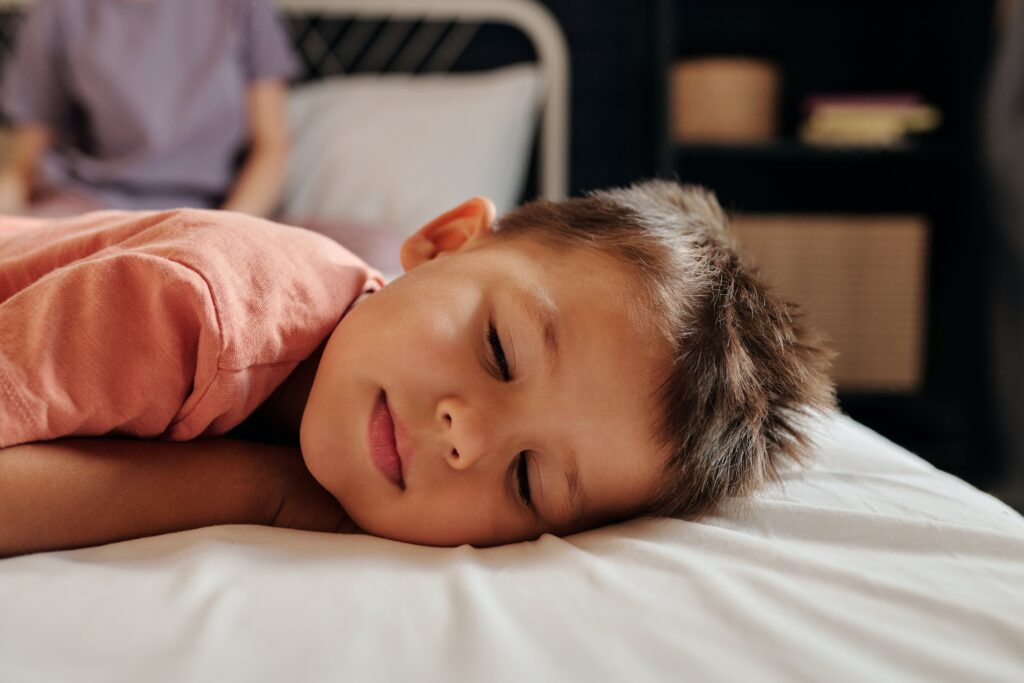Quite often I will get an email or phone call from a parent I haven’t heard from in years telling me that their perfect sleeper has started to disturb them at night, with the child frequently sleeping through the disturbance so she cannot recall it in the morning. Below are some of the most common causes I come across in these situations and the advice I give to parents. A common factor in all the below sleep discrepancies is overtiredness or a full bladder. Try to ensure that your child goes to bed early and empties her bladder each night 30 minutes before bedtime and then again just a minute before bed. It is also a good idea to limit drinks one hour before bed as part of your bedtime routine. If your child takes a drink to bed I recommend you stop this habit until the nights are peaceful again.
Read more tips below.
Nightmares
Most children experience nightmares at some stage. They normally occur in the last two-thirds of the night, after midnight and before 7 am, and are more common in families who have a history of nightmares. Nightmares are unlikely to be linked with any emotional problems and will normally stop happening without any help needed.
If you have a child who is having nightmares, the first thing I would advise is to stop your child from watching nearly all screens as this is often a trigger for nightmares. Sometimes nightmares can be a learnt attention-seeking behaviour – having a nightmare one night got so much attention that they decide to pretend to have more. Banning screen time and explaining to your child that it is because it is giving them nightmares can often discourage her from pretending to have them.
Sometimes children wake up screaming, repeating phrases like ‘go away’ or ‘no’, as if they are recalling something that has happened during the day. If this happens, you can try to wake your child gently to reassure her as much as possible. If she can remember the dream, you may have to give her a lot of comfort before she will return to sleep. Be careful not to suggest ideas or scenes by saying something like ‘Did you see a scary monster?’ or ‘Was it the bad man again?’ – often parents do this trying to reassure their child but actually make things worse.
You need to reassure her that although her fears seem real, her dreams are not. You can help her to learn the difference and your confidence in her ability to cope with the nightmares will help her enormously. If you can’t ban television altogether, try to keep tabs on what your child is watching, reading in books or seeing on her computer – avoid things that will compound her fears.

Night terrors
Despite being a very frightening experience to witness, a child who suffers from a night terror is not aware of it happening and will not remember it in the morning. Your child may give a piercing scream and be wide-eyed and anxious with dilated pupils, probably with sweat running down her forehead. If you go to pick her up or comfort her, you will notice her heart pounding and you may feel as though an evil spirit is trying to get out of your child. Your child will seem awake but is actually asleep. The night terror can last from a few seconds to over fifteen minutes. It is not advised to try to wake your child while the night terror is happening but you may like to sit and watch over her until it passes.
Night terrors are more common in boys than girls and occur in toddlers and preschoolers but can also affect older children. From my experience, they normally occur in the overtired child who is out of routine due to school holidays or friends or relatives visiting or some other disruption. If they are happening regularly, bringing your child’s bedtime forward half an hour can often cause the night terrors to stop.
Night terrors always occur in the non-dreaming first third of your child’s sleep, so before midnight, and normally at the exact same stage of sleep each night. I advise parents to stay with their child and note exactly what time they fall asleep, then look at the time the night terror starts. The next night, wake your child up before the night terror is due to start. For example, if your child went to bed at 7 pm but fell asleep at 7.21 pm and the night terror started at 10.14 pm, you would know the night terror started two hours and 53 minutes into sleep. The next night you would sit with your child until she falls asleep and then wake her two hours and 40 minutes later. If you do this for four nights running, the night terror pattern will usually be broken and they will disappear. When waking your child, do so slowly by talking to them, making sure they are fully awake. Your child will not be aware of the night terrors so will not be sure why you are waking them – you will have to come up with a good story, one that just can’t wait until the morning. Night terrors don’t harm or affect your child’s sleep at all.
Sleepwalking
Sleepwalking occurs when the movement centre in the brain remains active during sleep. In children, sleepwalking is more common in boys than girls and often runs in families. Children who sleepwalk are usually between the ages of six and sixteen, and the episodes normally happen in the first third of sleep, before midnight. Sleepwalkers may wander around the house for up to 30 minutes and may get dressed, open the fridge or even the front door. With this in mind, it is very important to make the environment safe where the sleepwalking is taking place. You should have the front door locked so that a child sleepwalking cannot open it but so you can in case of emergency.
Most sleepwalking children are unaware of what they are doing and won’t remember anything about it in the morning, so it is usually more worrying for the parents when they discover their child trotting around. Avoid awakening your child if she is sleepwalking, as this may frighten her. Simply steer her back to bed and ensure that she is safe. As overtiredness has been linked to sleepwalking, maintaining a bedtime routine will help minimise the problem. Putting your child to bed at the same time each night will avoid her getting overtired. Most sleepwalkers eventually stop on their own, although there are many adults who still wander around the house in pyjamas with a glazed expression!
Sleeptalking
Sleeptalking happens to children between three and ten years, again in the first third of the night (before midnight). It is impossible to hold a conversation with a sleeptalker – they tend to be talking to themselves and if you ask them a question you will only get a one-syllable answer. Children tend to be repeating the same thing while they talk in their sleep, saying things like ‘it’s mine’ or ‘get down’, as if going over something that happened in their day. Like sleepwalking children, sleeptalkers do not remember the incident in the morning and tend to grow out of it.
This holistic advice and more can be found in Save Our Sleep.
Follow the link to purchase: Save Our Sleep




